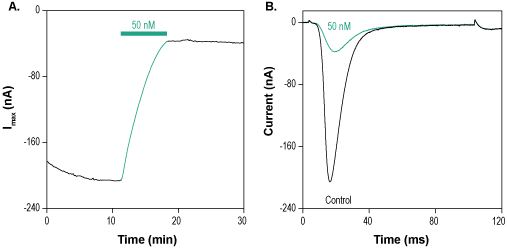Overview
- Rahnama, S. et al. (2017) PLoS One 12, e0173551.
 Alomone Labs m3-Huwentoxin IV blocks NaV1.7 channels expressed in Xenopus oocytes.A. Representative time course of m3-Huwentoxin IV (#STH-102) inhibition of NaV1.7 current. Membrane potential was held at -100 mV, current was elicited by a 100 ms voltage step to -10 mV every 10 sec, and gradually and irreversibly inhibited by 50 nM m3-Huwentoxin IV (green). B. Superimposed traces of NaV1.7 current after application of control (black) and of 50 nM m3-Huwentoxin IV (green). Taken from the recording in A.
Alomone Labs m3-Huwentoxin IV blocks NaV1.7 channels expressed in Xenopus oocytes.A. Representative time course of m3-Huwentoxin IV (#STH-102) inhibition of NaV1.7 current. Membrane potential was held at -100 mV, current was elicited by a 100 ms voltage step to -10 mV every 10 sec, and gradually and irreversibly inhibited by 50 nM m3-Huwentoxin IV (green). B. Superimposed traces of NaV1.7 current after application of control (black) and of 50 nM m3-Huwentoxin IV (green). Taken from the recording in A.
- Rahnama, S. et al. (2017) PLoS One 12, e0173551.
- Chow, C.Y. et al. Toxins (2015) 7, 2494.
- Klint J.K. et al. (2015) Br. J. Pharmacol. 172, 2445.
Huwentoxin IV is a peptide toxin originally isolated from the venom of the Chinese bird-eating spider Haplopelma schmitdi that acts as a potent and selective NaV1.7 channel blocker displaying an IC50 value of 26 nM1. m3-Huwentoxin IV is a mutated form of the toxin with significant increased potency towards NaV1.7, displaying an IC50 value of 0.4 nM1.
There are nine mammalian subtypes of voltage-gated sodium (NaV) channels: NaV1.1–NaV1.9. These channels responsible for propagating action potentials in excitable cells and considered to be important therapeutic targets for a wide variety of pathophysiological conditions such as cardiac arrhythmia, and epilepsy2,3.
NaV1.7 channel plays an important role in the human pain signaling pathway and it is an important therapeutic target for the treatment of chronic pain2,3.
m3-Huwentoxin IV (#STH-102) is a highly pure, synthetic, and biologically active peptide toxin. It is a mutated variant of Huwentoxin IV, a peptide toxin originally isolated from the Chinese bird-eating spider Haplopelma schmitdi venom. m3-Huwentoxin IV is a significantly more potent NaV1.7 channel bocker, displaying an IC50 value of 0.4 nM.

